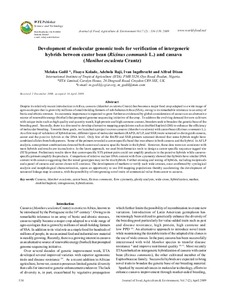| dc.contributor.author | Gedil, M. |
| dc.contributor.author | Kolade, F. |
| dc.contributor.author | Raji, A. |
| dc.contributor.author | Ingelbrecht, I.L. |
| dc.contributor.author | Dixon, A. |
| dc.date.accessioned | 2019-12-04T11:13:53Z |
| dc.date.available | 2019-12-04T11:13:53Z |
| dc.date.issued | 2009 |
| dc.identifier.citation | Gedil, M., Kolade, F., Raji, A., Ingelbrecht, I. & Dixon, A. (2009). Development of molecular genomic tools for verification of intergeneric hybrids between castor bean (Ricinus communis L.) and cassava (Manihot esculenta Crantz). Journal of Food, Agriculture & Environment, 7(2), 534-539. |
| dc.identifier.issn | 1459-0255 |
| dc.identifier.uri | https://hdl.handle.net/20.500.12478/2530 |
| dc.description.abstract | Despite its relatively recent introduction to Africa, cassava (Manihot esculenta Crantz) has become a major food crop adapted to a wide range of agro-ecologies that is grown by millions of small-holding farmers of sub-Saharan Africa (SSA), owing to its remarkable tolerance to an array of biotic and abiotic stresses. Its economic importance is expected to grow further as evidenced by global consideration of cassava as an alternative source of renewable energy (biofuel) that prompted genome sequencing initiative of the crop. To address the evolving demand for new cultivars with unique traits such as high quality and quantity starch, high protein and high carotene content, breeders seek to broaden the genetic base of the breeding pool. Secondly, there is a dire need to develop alternative mapping populations such as doubled haploid (DH) to enhance the efficiency of molecular breeding. Towards these goals, we launched a project to cross cassava (Manihot esculenta) with castor bean (Ricinus communis L.). As a first step of validation of hybridization, different types of molecular markers (RAPD, AFLP, and SSR) were screened to distinguish cassava, castor and the putative hybrids at the DNA level. Only few of the RAPD and SSR primers screened showed that some hybrids might have combined alleles from both parents. Some of the primers revealed a castor-specific band that was absent in both cassava and the hybrid. In AFLP analysis, some primer combinations detected both castor and cassava specific bands in the hybrid. However, these data were not consistent with most hybrids and results are inconclusive. In the latest approach, we used bioinformatics tools to design a castor specific sequence tagged site (STS) primer. Preliminary results show that castor-specific STS primer pairs could not amplify products in the putative hybrids while cassava- specific primers amplify the products. Comparison of relative nuclear DNA content with flow cytometry showed that hybrids have similar DNA content with cassava suggesting that the tested genotypes may not be true hybrids. Further crossing and testing of hybrids, including reciprocals and a panel of cassava and castor clones will continue. The development of markers to verify such wide crosses, once confirmed by cytological analysis and morphological characterization, opens an opportunity to use DH mapping populations thereby accelerating the development of saturated linkage map in cassava, with the possibility of introgressing novel traits of commercial value from castor to cassava. |
| dc.format.extent | 534-539 |
| dc.language.iso | en |
| dc.publisher | Science and Technology |
| dc.subject | Cassava |
| dc.subject | Manihot Esculenta |
| dc.subject | Castor Bean |
| dc.subject | Ricinus Communis |
| dc.subject | Flow Cytometry |
| dc.subject | Ploidy Analysis |
| dc.subject | Wide Cross |
| dc.subject | Hybridization |
| dc.subject | Marker |
| dc.subject | Doubled Haploid |
| dc.subject | Introgression |
| dc.subject | Hybridization |
| dc.subject | Dna |
| dc.subject | Hybrid |
| dc.subject | Mapping Population |
| dc.title | Development of molecular genomic tools for verification of intergeneric hybrids between castor bean (Ricinus communis L.) and cassava (Manihot esculenta Crantz) |
| dc.type | Journal Article |
| dc.description.version | Peer Review |
| cg.contributor.affiliation | International Institute of Tropical Agriculture |
| cg.coverage.region | Africa |
| cg.coverage.region | West Africa |
| cg.coverage.country | Nigeria |
| cg.isijournal | ISI Journal |
| cg.authorship.types | CGIAR single centre |
| cg.iitasubject | Cassava |
| cg.iitasubject | Farming Systems |
| cg.iitasubject | Food Security |
| cg.iitasubject | Impact Assessment |
| cg.iitasubject | Plant Breeding |
| cg.iitasubject | Plant Genetic Resources |
| cg.iitasubject | Plant Diseases |
| cg.iitasubject | Plant Production |
| cg.iitasubject | Value Chains |
| cg.iitasubject | Pests Of Plants |
| cg.journal | Journal of Food, Agriculture & Environment |
| cg.howpublished | Formally Published |
| cg.accessibilitystatus | Limited Access |
| local.dspaceid | 93281 |

